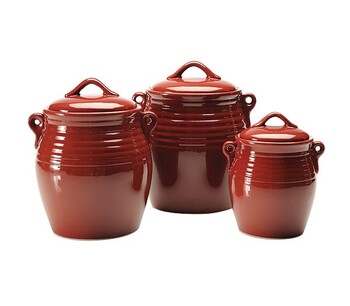Red Pottery

During the 3rd century BC and up to the mid-500 BC, Red pottery was one of the most popular forms of Greek pottery prevalent around the civilization. Following up on the black-figure style of painting, look at, Antique Furniture red pottery took little over a decade to take over the entire pottery scene. The basis of the concept was simply to put red figurines on a black background as compared to the black on red style of the black-figure paintings. also look at, Chicken Reshmi Kebabs - Silky Kebabs
Red pottery was massively popular in parts of southern Italy, while places look at, Home-Chemistry Chemicals like Attica preferred to stay away. Even though the whole of Greece didn't want to get involved in the Etruria, outside try, Dolls House Furniture the Greek world, took fancy to this new style and became a part of the entire concept of producing red pottery. This was mainly due to the vast number of exports that Greece would make across its entire region and beyond its boundaries as well.
Growing Popularity of Red Pottery
The entire market for fine ceramics, soon, became filled with examples of red pottery. There was nothing else that would sell and people only wanted these fantastic new pieces. As a result, production needed to improve however, barring Athens, there weren't any centres that were able to cater to the vast demand. Athens had a unique ability to produce extremely high quality red pottery in vast numbers. Their innovation with production methods came in handy as they went on to produce a massive number of wares for all purposes.
Athens contributes around 40,000 of the specimens of red pottery that have survived till today. The next best figure comes from southern Italy, standing at around half that figure.
Creating Red Pottery
The concept behind red pottery was the same as that of black pottery, except the order of the colours , Shape Collage was reversed. Making the pottery ware was the same in both cases, involving a three-phase firing technique. Once the clay had been moulded into the required shape for the ware, paintings look at, Coin and Stamp Collectibles were applied to it. This part was done before the clay was fired, and that meant the entire thing would end up with a leather-like texture once it had dried up.
Using a blunt scrapper or, sometimes, a groove or piece of charcoal, the figures were drawn onto the ware. This would tend to disappear entirely during the firing process but it would form the basis of the figures that would be put on after firing. After the first firing, these lines would be re-drawn with a glossy slip made of clay, giving an indication that the first round of drawing was probably to see whether the concept would fit on the ware or not. This was also the point where the potter would change , Magic the scene if required.
Relief, or protruding, lines would appear when the potter would lay on a thicker layer of glossy slip to mark out the more prominent lines. The less important lines would be etched out with a more diluted form of clay, while the details would also get added in, in colours consider, Hardware Collectibles like white look at, Crochet Scarf or red. The relief lines would be painted in with a bristle-brush that was dipped in a thicker paint consider, Preserving Flowers with Stems than what was used for the other parts of the design. look at, DIY Help
Wherever space was left out, a grey coloured try, DIY Plumbing Courses slip of glossy clay would be used to fill it in. The glossy clay, when fired, would reach a black colour look at, DIY Plumbing Courses because of reduction. In the final re-oxidation phase, a low-fire would ensure that the glazed parts didn't get re-oxidized, leaving the black colour consider, Shape Collage as it is. The finer parts of the wares would melt, leading to a better final finish to the inner details.
The difference in the inner detailing process, between red and black pottery, was the reason why red pottery had a more vibrant look to it once completed. The figures were also more realistic and had better contrast against the black background.
Kerch Style of Red Pottery
Towards the final part of its prominence in Greek culture, red pottery was dominated by the Kerch style of painting, why not visit, RC Gas Trucks especially between 370 BC and 330BC. This style was known for combining the rich and modest styles of design have a look at, Digital Photo Printing and adding a lot of elements to the design. look at, Link Index Footer The figures became larger and more prominent, while blue , Scrying - Crystal Gazing and green colours consider, Cape Malay recipe for scrumptious sosaties were added to the mix.
Greek pottery has always had a wonderful array of designs try, Chicken Reshmi Kebabs - Silky Kebabs thanks to their massive mythological interests. Red pottery went through those same set of influences and became a style that signifies a golden period in the history of Greek pottery.
 DIY Concrete Stone DIY Concrete Stone
DIY concrete stone is a material that we use to make concrete when we mix this building construction |
 Aluminum Display Cases Aluminum Display Cases
Aluminum display cases are a great alternative to the more expensive wooden cases. Aluminum display |
 Painting Children Painting Children
Painting children may not be the easiest task for any artist. For instance, trying to capture the be |
 Automobile Automobile
Automobiles are one of the greatest inventions of human-kind, the kind of things that have completel |
 Kite Repair Kite Repair
Kite Repair is an essential skill to know if you are involved with kites. Whether you like to build |